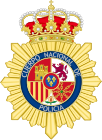Spanish National Police
|
National Police Force Cuerpo Nacional de Policía |
|||||||
|---|---|---|---|---|---|---|---|
| Common name | Policía Nacional | ||||||
| Abbreviation | CNP | ||||||

Seal of the National Police Corps of Spain
|
|||||||

Badge of the National Police Corps of Spain
|
|||||||

Flag of the National Police Corps of Spain
|
|||||||
| Motto |
Ley y Orden Law and Order |
||||||
| Agency overview | |||||||
| Formed | March 13, 1986 | ||||||
| Preceding agencies |
|
||||||
| Legal personality | Governmental: Government agency | ||||||
| Jurisdictional structure | |||||||
|
National agency (Operations jurisdiction) |
Spain | ||||||
| Population | 46,661,950 | ||||||
| Legal jurisdiction | As per operations jurisdiction. | ||||||
| Governing body | Government of Spain | ||||||
| Constituting instruments |
|
||||||
| General nature | |||||||
| Operational structure | |||||||
| Overviewed by | Directorate-General of the Police and the Civil Guard | ||||||
| Headquarters | Calle Miguel Ángel, 5, 28039 Madrid, Spain | ||||||
| Officers | 87,872 | ||||||
| Minister responsible | Jorge Fernández Díaz, Minister of the Interior | ||||||
| Agency executive | Ignacio Cosidó, Director-General | ||||||
|
|||||||
| Website | |||||||
| http://www.policia.es | |||||||
| Notables | |
|---|---|
| Anniversary | October 2 |
| Award | Order of Police Merit |
The National Police Corps (Spanish: Cuerpo Nacional de Policía, CNP; [ˈkwerpo naθjoˈnal de poliˈθi.a]) is the national civilian police force of Spain. The CNP is mainly responsible for policing urban areas, whilst countryside policing is generally the responsibility of the Civil Guard, the Spanish gendarmerie. The CNP operates under the authority of Spain's Ministry of the Interior. They mostly handle criminal investigation, judicial, terrorism and immigration matters. The powers of the National Police Force varies according to the autonomous communities, Ertzaintza in the Basque Country, Mossos d'Esquadra in Catalonia, and Policía Foral (Foruzaingoa) in Navarre are the primary police agencies while BESCAM in the Madrid region is more of a resources provider. In Andalusia, Aragon, Asturias, Galicia, and Valencia the National Police units are functionally acting directly under the orders of the Autonomous Communities to which they are attached.
The 1986 organic law unifying the separate uniformed and plainclothes branches of the national police was a major reform that required a considerable period of time to be brought into full effect. The former plainclothes service, known as the Superior de Policía (Higher Police Force), but often referred to as the "secret police" (former the General Police Service), consisted of some 9,000 officers. Prior to 1986, it had a supervisory and coordinating role in police operations, conducted domestic surveillance, collected intelligence, investigated major crimes, issued identity documents, and carried out liaison with foreign police forces.
...
Wikipedia
